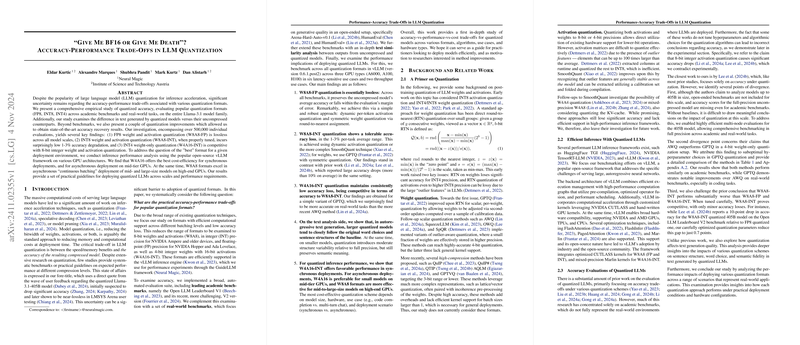Performance-Accuracy Trade-Offs in LLM Quantization
The ongoing evolution of LLMs has been accompanied by significant computational and operational challenges, particularly at inference time. The paper "Give Me BF16 or Give Me Death"? Accuracy-Performance Trade-Offs in LLM Quantization addresses this challenge by examining the intricacies of model quantization as a means to enhance inference efficiency without compromising model accuracy. This empirical paper focuses on a rich set of quantization formats—FP8, INT8, and INT4—evaluated across a broad spectrum of academic and real-world benchmarks using the Llama-3.1 model family.
Central to the paper is the exploration of the accuracy-performance trade-offs inherent in model quantizations. The paper highlights an extensive evaluation involving over 500,000 assessments and provides significant insights:
- FP8 Quantization Efficacy: The paper finds that FP8 quantization (W8A8-FP) is lossless across various model scales, thereby enabling the retention of the original model’s accuracy while making it inference-ready with reduced operational requirements.
- INT8 Performance: Properly tuned INT8 quantization (W8A8-INT) demonstrates a surprisingly small accuracy degradation, maintaining just a 1-3\% loss on average. This is particularly noteworthy as previous conceptions indicated significant losses when using INT8 quantized activations.
- Competitive INT4 Quantization: INT4 weight-only quantization (W4A16-INT) reveals competitive performance compared to its 8-bit counterpart in specific scenarios, challenging previous stances that underscored considerable accuracy sacrifices with lower-bit quantization.
In addition to theoretical evaluations, the paper ventures into pragmatic areas, particularly regarding inference performance, using the vLLM framework across various GPU architectures. This exploration reveals that despite different hardware requirements and task demands, quantization can be optimized for different deployment environments. W4A16, for instance, demonstrated cost-efficiency advantages in synchronous deployments, while W8A8 was advantageous for asynchronous deployments on advanced GPUs.
The paper's depth in bridging the gap between theoretical accuracy and practical deployment capability provides several guidelines for efficient deployment of quantized LLMs. The key takeaway remains that with considered quantization strategies, significant computational savings can be realized without compromising the qualitative outputs expected from LLMs.
Implications and Future Directions
The findings underscore the potential of model quantization for broad applications, especially in democratizing access to LLM capabilities by reducing inference costs. The demonstrated efficacy of these quantization approaches could inspire further advancements in inference acceleration and reduced resource consumption, likely stimulating new research into compression algorithms.
Future work may explore more complex deployment scenarios, emphasizing multi-modal tasks and diverse architectures beyond GPUs. Furthermore, as LLMs continue to grow in size and application bandwidth increases, there might be a need for more nuanced quantization strategies that intelligently adapt to task-specific requirements or alternate between precision levels dynamically depending on contextual needs.
In summary, this paper provides a comprehensive benchmark of quantization methodologies, offering a detailed reference that practitioners and researchers can leverage to optimize LLM deployments. By doing so, it also lays a foundation for future works aimed at improving quantization techniques and expanding their applicability across various machine learning and artificial intelligence domains.
